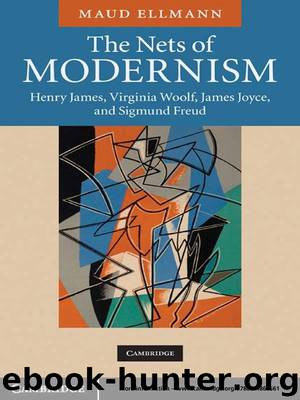The Nets of Modernism by Ellmann

Author:Ellmann
Language: eng
Format: epub, mobi
ISBN: 9780511853791
Publisher: Cambridge University Press
Published: 2011-03-01T00:00:00+00:00
Here Bloom’s keyhole view recalls the anorthoscopic vision of the narrator of “Araby,” who spies on his beloved through the slit beneath the blind. Bloom’s response to the spectacle – “Show! Hide! Show!” – implies that his vicarious excitement depends on both the showing and the hiding, on the frictional alternation of vision and blindness. Concealed from the lovers, Bloom occupies a similar position to Lenehan in “Two Gallants,” who also wants to see without being seen. Instead of competing for the affections of the slavey, Lenehan merely wants “a squint of her.” When Corley snaps, “Are you trying to get inside me?” Lenehan insists that his intentions are purely scopophilic: “All I want is to have a look at her. I’m not going to eat her.” He eats a meager dish of peas instead, while Corley gets inside her.
In Lenehan’s lonely meal, a degraded or simoniac sacrament, food provides a substitute for off-stage sex in the same way that the gold coin stands in for the absent phallus. Throughout Dubliners, food, sex, words, and money function as symbolic equivalents for one another, much as florins, rats, and excrement become equivalents for one another in the deliria of Freud’s Rat Man (SE 10:213–16). In “Two Gallants,” Corley exchanges sex and gallantries for money, whereas Lenehan exchanges words for drink. No one knows how Lenehan achieves “the stern task of living,” but we learn that his tongue is “tired” from entertaining fellow drunkards in the hope of being treated to their rounds. Here it is worth noting that Joyce also paid his way with words, “armed with a vast stock of stories, limericks, and riddles,” as he writes of Lenehan. Joyce achieved the stern task of living by sponging off acquaintances, flaunting a Lenehanian economy of freeloading in defiance of bourgeois thrift. Lenehanian, too, was Joyce’s interest in the sexual exploits of his rivals. Lenehan could therefore be seen as Joyce’s portrait of the artist as a young man gone to seed – as a scrounger, wordmonger, and peeping Tom.
The erotic triangle in “Two Gallants” resembles Freud’s account of dirty jokes, in which the woman functions as the blind or pretext rather than the partner of the “smut” exchanged between two men. Smut, Freud argues, originates in sexual aggression directed at a woman, but the presence of a male third person diverts this impulse into the detour of a dirty joke. In polite society, men “save up” their jokes for times when they can be “alone together,” excluding women from their smutty talk. Thus the woman, originally the addressee, latterly the butt, and finally the sacrificial victim of the joke, vanishes from the scene of masculine pleasure, reduced to the ghost of a deflected rape. 55
In the course of Joyce’s evolution as a writer, however, the woman increasingly asserts her independence, refusing to be blotted out by in-jokes between men. It is in Molly Bloom’s soliloquy that the slavey finally talks back; here it is worth remembering that Nora Barnacle was
Download
This site does not store any files on its server. We only index and link to content provided by other sites. Please contact the content providers to delete copyright contents if any and email us, we'll remove relevant links or contents immediately.
| African | Asian |
| Australian & Oceanian | Canadian |
| Caribbean & Latin American | European |
| Jewish | Middle Eastern |
| Russian | United States |
4 3 2 1: A Novel by Paul Auster(12284)
The handmaid's tale by Margaret Atwood(7679)
Giovanni's Room by James Baldwin(7192)
Asking the Right Questions: A Guide to Critical Thinking by M. Neil Browne & Stuart M. Keeley(5636)
Big Magic: Creative Living Beyond Fear by Elizabeth Gilbert(5614)
Ego Is the Enemy by Ryan Holiday(5294)
The Body: A Guide for Occupants by Bill Bryson(4974)
On Writing A Memoir of the Craft by Stephen King(4863)
Ken Follett - World without end by Ken Follett(4645)
Adulting by Kelly Williams Brown(4487)
Bluets by Maggie Nelson(4474)
Eat That Frog! by Brian Tracy(4435)
Guilty Pleasures by Laurell K Hamilton(4360)
The Poetry of Pablo Neruda by Pablo Neruda(4039)
Alive: The Story of the Andes Survivors by Piers Paul Read(3968)
White Noise - A Novel by Don DeLillo(3954)
Fingerprints of the Gods by Graham Hancock(3942)
The Book of Joy by Dalai Lama(3901)
The Bookshop by Penelope Fitzgerald(3776)
